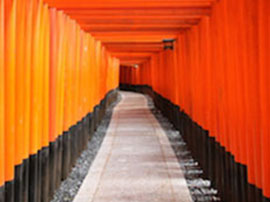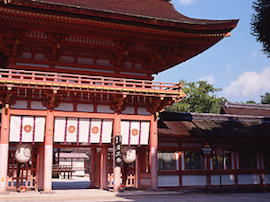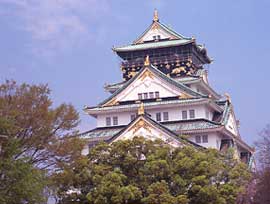
Eastern Kyoto
The eastern part of Kyoto is highly recommended for the large number of popular shrines and temples there, including Kiyomizu-dera and Ginkaku-ji.
Kiyomizu-dera Temple
A UNESCO World Heritage Site. The main Buddha image is an eleven-faced, thousand-armed Goddess of Mercy. After Sakanoue no Tamuramaro came to the area to hunt deer, a monk admonished him against the taking of life. In response, Sakanoue built the thousand-armed Goddess of Mercy statue and work on the hall was begun. The main building, generally referred to as the "Kiyomizu stage," was rebuilt in 1633. Selected along with the Great Wall of China and the Eiffel Tower of France as the sole finalist from Japan in an initiative by a Swiss foundation as candidates for the "New 7 Wonders of the World," Kiyomizu-dera Temple received an award.
Rising 13 meters, the Kiyomizu-dera stage was built of wood without the use of a single nail. In Japan, the expression "jump off the stage of Kiyomizu" is equivalent to the English "take the plunge" when doing something with absolute resolve. And according to records kept since 1694, there have been 234 people who have "taken the plunge" from the stage with a survival rate of 85%. In 1872, the government issued an order prohibiting further jumps. In the back of the main buildings is a shrine to the tutelary deity, known as a place where marriage matches are formed.
A pair of "love fortune-teller stones" are said to give people their wishes if they pray with their eyes closed while crossing from one stone to the other. Also, near the Nio (Deva) Gate is a statue of Jizo (Ksitigarbha) with his head turned. It is said that if you make your wish while turning its head in that direction, it will come true.
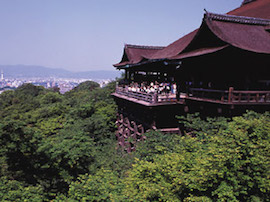
| Open hours: |
The opening and closing times for Kiyomizu-dera Temple vary throughout the year. When there are special openings at night, the gates close for a short time and open again. |
|---|---|
| Admission: |
High school students and older: 400 yen Junior high school students and younger: 200 yen |
| Address: | 1-294 Kiyomizu, Higashiyama-ku, Kyoto, Kyoto Prefecture |
| URL: | http://www.kiyomizudera.or.jp/en/ |
| Access: | +81-(0)75-551-1234 |
| Access: | Take Keihan Electric Railway to Gojo Station. It is a 25-minute walk. |
Ginkaku-ji – Temple of the Silver Pavilion
A UNESCO World Heritage Site. Ashikaga Yoshimasa (1436-90), eighth shogun of the Muromachi government, emulated Kinkaku-ji (Temple of the Golden Pavilion) built by his grandfather, and created Higashiyama-dono, later remodeled into the Silver Pavilion temple. The Goddess of Mercy Hall, known as Ginkaku or the Silver Pavilion, was lacquered on the outside, but whether silver leaf was intended to be put over that is not known. Another building on the premises is Togudo, which served as Yoshimasa's study.
It is the oldest extant example of a tatami mat writing alcove and of staggered shelves, and is a valuable cultural property demonstrating what later came to be known as the shoin-zukuri architecture. Togudo is also a valuable property as an example of a tea room. Its simple form raised awareness of the aesthetic concept of wabi-sabi, which encompasses imperfection and austerity, and is a symbol of the Higashiyama culture. The garden has a pond with a path around it in the chisen kaiyu design style advocated by Yoshimasa.
Although the feel of the Muromachi era permeates the garden, the white sand built into the shape of Mount Fuji (a kogetsudai) and the ginsha-dan or silver wave pattern employed give a distinctly modern aesthetic despite the Edo period construction. The contrast between the old style and the seeming new style is a point of great interest.
| Open hours: |
8:30 a.m. to 5:00 p.m. (9:00 a.m. to 4:30 p.m. from December through February) |
|---|---|
| Admission: |
Adults: 500 yen Elementary and junior high school students: 300 yen |
| Address: | 2 Ginkaku-ji-cho, Sakyo-ku, Kyoto, Kyoto Prefecture |
| URL: | http://www.shokoku-ji.jp/g_access.html |
| Phone: | +81-(0)75-771-5725 |
| Access: |
• Take Kyoto city bus 5/17/32/100/102/203/204 to the Ginkaku-ji-michi bus stop. It is a 10-minute walk. • Take Kyoto Bus 18/56 to the Ginkaku-ji-michi bus stop. It is a 10-minute walk. |
Eikan-do Temple
The tree colors of autumn are so prominent here, Eikan-do Temple has been synonymous with autumn leaf viewing since days of yore. There are some three thousand maples on the grounds, which are lit up at night during the autumn viewing season. The main Buddha image is the "Amida Looking Back," with the neck rotated to the left.
An unusual depiction capturing a moment of Amida, this is counted as one of the six great Amida Buddhas of Kyoto. The temple grounds are on a mountain slope, and one never tires of walking around the extensive area or going up and down the corridors. Even in years when the fall leaves do not reach their full potential, the trees here are praised for their remarkable beauty.
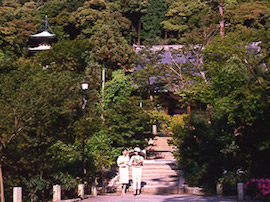
| Open hours: |
9:00 a.m. to 5:00 p.m. Admission ends at 4:00 p.m. |
|---|---|
| Admission: |
Adults: 600 yen Elementary and junior high school students: 400 yen |
| Address: | 48 Eikan-do-cho, Sakyo-ku, Kyoto, Kyoto Prefecture |
| URL: | http://www.eikando.or.jp/English/index_eng.htm |
| Phone: | +81-(0)75-761-0007 |
| Access: | Take the Kyoto Municipal Subway Tozai Line to Keage Station. It is a 15-minute walk. |
Yasaka Shrine
According to tradition, Yasaka Shrine was built in the year 656, about 150 years before Kyoto became Japan's capital. Gion Festival, one of the three great festivals of Japan, originated in the year 869 when an epidemic spread. Sixty-six halberds were erected on the grounds of Yasaka Shrine and portable shrines were taken out and paraded to pray for an end of the disease. Utsukushi Gozen-sha Shrine, famous for its goddess of beauty, is situated in the eastern portion of the shrine compound. Geisha and maiko (geisha-in-training) come from Gion to pray to the goddess for financial prosperity, talent and beauty. Shijo-dori, the main street of Kyoto, comes to an end at beautiful Nishiro-mon Gate, a towering brightly vermilion-painted gate that is a popular place for taking pictures. Constructed with a unique feature where two structures share one roof, the main building has an endless stream of people every day praying with great dedication. Holy spring water flows in front of Utsukushi Gozen-sha Shrine. Excellent for healthy skin, visitors joyously use the water as a beauty treatment.
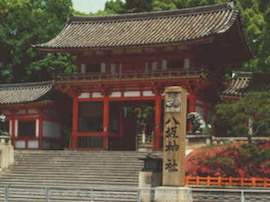
| Open hours: |
The grounds are always open |
|---|---|
| Admission: |
There is no admission charge to the grounds. |
| Address: | 625 Gion-machi Kitagawa, Higashiyama-ku, Kyoto, Kyoto Prefecture |
| URL: | http://www.yasaka-jinja.or.jp/en/ |
| Phone: | +81-(0)75-561-6155 |
| Access: |
• Take Keihan Electric Railway to Gion-Shijo Station. It is a five-minute walk. • Take Hankyu Railway to Kawaramachi Station. It is an eight-minute walk. |
Kodai-ji Temple
Constructed by Nene (also known as Kita no Mandokoro), wife of the Warring State general Hideyoshi Toyotomi who unified Japan, to pray for Toyotomi's bliss in the afterworld, Kodai-ji Temple gets its name from Nene's posthumous Buddhist name Kodai-in. Despite several occurrences of fires, many of the original structures remain standing. The mausoleum enshrining Toyotomi and Nene is decorated luxuriously. The interior makie craftsmanship (gold and silver lacquer adornment) in particular is resplendent and referred to as Kodai-ji makie.
The tearoom, moved from Fushimi Castle where tea ceremony devotee Toyotomi lived, is also worth seeing. The chisen kaiyu garden with a pond and a walking path has trees planted to surround the pond. During the cherry blossom season and in the fall, the area is lit up, creating a fantastic atmosphere, particularly in autumn when the bright colors of leaves reflect in the pond and create a fantastic atmosphere. The vermilion-colored leaves beyond the window are so vivid, they look like a painting.
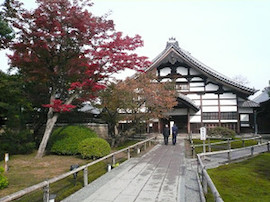
| Open hours: |
9:00 a.m. to 5:30 p.m. Admission ends 30 minutes before closing time. |
|---|---|
| Admission: |
Adults: 600 yen Junior high and high school students: 250 yen |
| Address: | 526 Kodai-ji Shimokawara-cho , Higashiyama-ku, Kyoto, Kyoto Prefecture |
| URL: | http://www.kodaiji.com/e_index.html |
| Phone: | +81-(0)75-561-9966 |
| Access: |
Take Keihan Electric Railway to Gion-Shijo Station. It is a 15-minute walk. |
Sanjusangen-do Temple
Sanjusangen-do Temple was constructed in 1164 by order of Emperor Go-Shirakawa. Although officially known as "Rengeo-in" (Hall of the Lotus King), the temple's more common name Sanjusangen-do (hall of 33 spaces) comes from the fact that there are 33 spaces between the pillars in the main building. At the center of the main building is a thousand-armed Goddess of Mercy, and along the entire 120 meters of the building is an amazing display of thousand-armed Goddess of Mercy statues, some thousand in all, made of wood. Every year on the Sunday closest to January 15, an archery contest known as Yumi Hiki Hajime (first draw of the year) is held along the long main building. The thousand-armed Goddess of Mercy statues have different faces, and it is said that if you pray to meet someone, you will find that person's face among the statues.
| Open hours: |
8:00 a.m. to 5:00 p.m. (9:00 a.m. to 4:00 p.m. between November 16 and March).Admission ends 30 minutes before closing time. |
|---|---|
| Admission: |
Adults: 600 yen Junior high and high school students: 400 yen Elementary school students: 300 yen |
| Address: | 657 Sanjusangen-do Umawari-cho, Higashiyama-ku, Kyoto, Kyoto Prefecture |
| URL: | http://sanjusangendo.jp/ |
| Phone: | +81-(0)75-561-0467 |
| Access: |
Take Keihan Electric Railway to Shichijo Station. It is a seven-minute walk. |
Heian Jingu Shrine
Heian Jingu Shrine was built in 1895 to commemorate the 1100th anniversary of the founding of the Heian capital in Kyoto. The attractive main building is a reproduction of the Outer Palace Precincts of the Heian capital and Oten-mon Gate on an eight-to-five scale, and gives a realistic feel for the size of the capital at the time. Heian Shrine is also known as the location for Jidai Matsuri, one of the three great festivals of Kyoto.
The festival procession recreates Kyoto's history with elegance, the participants dressing themselves in beautiful clothing from the past. A great vermilion-colored torii gate is the symbol of the shrine. A vast sacred garden surrounds the main building and provides a variety of plants and trees for visitors to enjoy through the seasons. It is said that the beautiful garden was used for garden parties, a feature truly representative of the imperial world in the Heian Period.
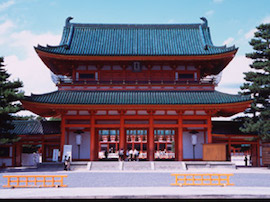
| Open hours: |
6:00 a.m. to 6:00 p.m. (Shin'en: 8:30 a.m. to 5:30 p.m.) Please note that the schedule is subject to change according to season. |
|---|---|
| Admission: |
There is no admission charge to the grounds. Shin'en: Adults: 600 yen Elementary school students: 300 yen |
| Address: | 97 Okazaki Nishitenno-cho, Sakyo-ku, Kyoto, Kyoto Prefecture |
| URL: | http://www.heianjingu.or.jp/ |
| Phone: | +81-(0)75-761-0221 |
| Access: |
• Take Keihan Electric Railway to Jingu-Marutamachi Station. It is a 15-minute walk. • Take the Kyoto Municipal Subway Tozai Line to Higashiyama Station. It is a 10-minute walk. |
Attractions along the Keihan line
Discount Tickets
When using Keihan Electric Railway, passes for visitors to Japan are a convenient way to get around. Not only do you get unlimited rides on Kyoto and Osaka lines, the passes come with a number of other benefits. For travel in Osaka and Kyoto, these passes are indispensable!

